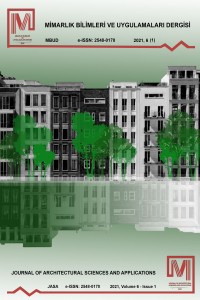Abstract
Keywords
Turkish House Yalvaç Tıraşzade Mansion Turkish culture vernacular housing space organization
Thanks
I would like to extend my thanks to Yalvaç Municipality, which generously shared information and photos about the Tıraşzade Mansion. The copyright of the photos and drawings in Table 2 belongs to the municipality. The article complies with national and international research and publication ethics. Ethics committee permission was not required for the study.
References
- Beyaz, E. (2017). Beyşehir’deki XIII. ve XIV. Yüzyıl Camilerinin Biyofilik Kriterler Üzerinden İncelenmesi. KTO Karatay Üniversitesi Fen Bilimleri Enstitüsü Mimarlık Ana Bilim Dalı, Yüksek Lisans Tezi, Konya.
- Fromm, E. O. (1964). The Heart of Man. UK: Harpercollins.
- Gündüz, E. (2019). Mimaride Doğayı Temel Alan Tasarım Yaklaşımları İzleği. İstanbul Teknik Üniversitesi Fen Bilimleri Enstitüsü Mimarlık Anabilim Dalı, Yüksek Lisans Tezi, İstanbul.
- Kara, D. (2004). Bir Biyofilik Olarak Joseph Beuys ve Sanatı. Marmara Üniversitesi Güzel Sanatlar Enstitüsü Resim Ana sanat Dalı, Yüksek Lisans Tezi, İstanbul.
- Kayıhan, K. (2018). Examination of Biophilia Phenomenon in the Context of Sustainable Architecture. Erişim adresi (10.02.2019): https://www.researchgate.net/publication/324063335.
- Kayıhan, K., Güney S. ve Ünal F. (2018). Biophilia as the Main Design Question in Architectural Design Studio Teaching. Megaron, 13(1):1-12.
- Kellert, S. ve Calabrese, E. (2015). The Practice of Biophilic Design. Erişim adresi (12.02.2019): www.biophilic-design.com
- Ünlü, E. (2017). Mimarlıkta Biyofili Olgusu ve Sağlık Yapıları Örneği. Gebze Teknik Üniversitesi Fen Bilimleri Enstitüsü Mimarlık Anabilim Dalı, Yüksek Lisans Tezi, Gebze.
- Wilson, E. (1984). Biophilia, ABD. Erişim Adresi (14.03.2019): https://epdf.pub/biophilia.html
- Yıldırım, M., Dalkılıç, N., Halifeoğlu, F. M., Dağtekin, E. ve Payaslı Oğuz, G. (2012). D. Ü. Mimarlık Fak. Rölöve Teknikleri Dersi Öğrenci Çalışmaları, TMMOB Diyarbakır Şubesi Yayınları, 1. Baskı.
Abstract
References
- Beyaz, E. (2017). Beyşehir’deki XIII. ve XIV. Yüzyıl Camilerinin Biyofilik Kriterler Üzerinden İncelenmesi. KTO Karatay Üniversitesi Fen Bilimleri Enstitüsü Mimarlık Ana Bilim Dalı, Yüksek Lisans Tezi, Konya.
- Fromm, E. O. (1964). The Heart of Man. UK: Harpercollins.
- Gündüz, E. (2019). Mimaride Doğayı Temel Alan Tasarım Yaklaşımları İzleği. İstanbul Teknik Üniversitesi Fen Bilimleri Enstitüsü Mimarlık Anabilim Dalı, Yüksek Lisans Tezi, İstanbul.
- Kara, D. (2004). Bir Biyofilik Olarak Joseph Beuys ve Sanatı. Marmara Üniversitesi Güzel Sanatlar Enstitüsü Resim Ana sanat Dalı, Yüksek Lisans Tezi, İstanbul.
- Kayıhan, K. (2018). Examination of Biophilia Phenomenon in the Context of Sustainable Architecture. Erişim adresi (10.02.2019): https://www.researchgate.net/publication/324063335.
- Kayıhan, K., Güney S. ve Ünal F. (2018). Biophilia as the Main Design Question in Architectural Design Studio Teaching. Megaron, 13(1):1-12.
- Kellert, S. ve Calabrese, E. (2015). The Practice of Biophilic Design. Erişim adresi (12.02.2019): www.biophilic-design.com
- Ünlü, E. (2017). Mimarlıkta Biyofili Olgusu ve Sağlık Yapıları Örneği. Gebze Teknik Üniversitesi Fen Bilimleri Enstitüsü Mimarlık Anabilim Dalı, Yüksek Lisans Tezi, Gebze.
- Wilson, E. (1984). Biophilia, ABD. Erişim Adresi (14.03.2019): https://epdf.pub/biophilia.html
- Yıldırım, M., Dalkılıç, N., Halifeoğlu, F. M., Dağtekin, E. ve Payaslı Oğuz, G. (2012). D. Ü. Mimarlık Fak. Rölöve Teknikleri Dersi Öğrenci Çalışmaları, TMMOB Diyarbakır Şubesi Yayınları, 1. Baskı.
Details
| Primary Language | English |
|---|---|
| Subjects | Architecture |
| Journal Section | Research Articles |
| Authors | |
| Publication Date | July 1, 2021 |
| Submission Date | September 28, 2020 |
| Published in Issue | Year 2021 Volume: 6 Issue: 1 |


